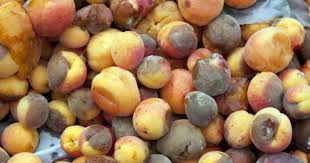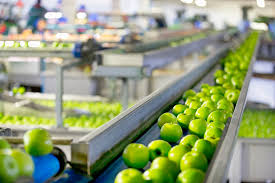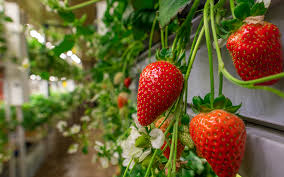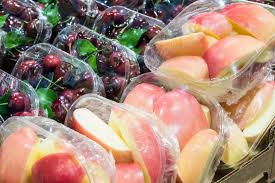In the field and during storage, crop products are threatened by insects, rodents, birds, and other pests. Additionally, the products may become spoiled through infection from fungi, yeasts, or bacteria.
Losses in both quantity and quality affect crops between harvest and consumption. The magnitude of postharvest losses in fresh fruits and vegetables is estimated to be between 5 to 25 per cent in developed countries and 20 to 50 per cent in developing countries, depending on the commodity, cultivar, and handling conditions.
To reduce these losses, it is important for producers and handlers to understand the biology and environmental factors involved in deterioration.
Fresh fruits, vegetables, and ornamentals are living tissues that undergo continuous change after harvest. While some of these changes are desirable, most are not, from a consumer standpoint. Postharvest changes in fresh produce cannot be completely stopped, but they can be slowed within certain limits.
Read Also: Challenges and Potential of Snail Farming
Agents Responsible for the Deterioration of Stored Grains
1. Micro-organisms: These include moulds, yeasts, and bacteria which are biological agents found in soil. When transported by air or water, they can contaminate products before, during, and after harvest.
Their growth leads to significant changes in the nutritive value and sensory properties of grain (taste, smell, appearance).
In addition, they alter the germinative properties of seeds such as vigour and the ability to sprout. In the case of moulds, they may also produce harmful poisons called mycotoxins.
Impurities, along with cracked or broken grains, promote the growth of micro-organisms. Temperature and humidity play a major role in determining the rate of microbial growth.
Micro-organisms can thrive at temperatures between -8°C and +80°C when the relative humidity exceeds 65 per cent. Conversely, low-oxygen atmospheres help suppress their development.
2. Insects: Infestations may occur in the field before harvest or in storage facilities. In some cases, these infestations are not visible to the naked eye, as damage is caused by larvae developing inside the grain. The insects most commonly found in stored products belong to the following families:
i. Coleoptera (both larvae and adults cause damage)
ii. Lepidoptera (only larvae cause damage)
Insects contribute significantly to product loss. Their biological activities, such as waste production and respiration, reduce the quality and commercial value of stored grain and promote microbial growth.
Insects thrive at temperatures between +15°C and +35ºC. Low humidity slows or halts their development, while oxygen deficiency can quickly eliminate them.
3 . Rodents: These animals invade and multiply in or around storage areas, where food is abundant. They cause substantial damage not only to the stored products but also to packaging materials and storage structures. The most common rodent species that attack stored products include:
i. The black rat or roof rat (Rattus rattus)
ii. The brown or Norway rat, also known as the sewer rat (Rattus norvegicus)
iii. The mouse (Mus musculus)
Continuous rodent attacks result in serious quantitative losses. Moreover, quality losses arise from contamination by rodent waste (excrement and secretions), which affects food hygiene and marketability. Rodents are also known vectors of severe diseases such as rabies and leptospirosis.
Biological Factors Contributing to the Deterioration of Horticultural Crops

1. Respiration and Perishability
The rate at which harvested commodities deteriorate is generally proportional to their respiration rate. Based on their respiration and ethylene production patterns during maturation and ripening, fruits are classified as either climacteric or non-climacteric.
i. Climacteric fruits experience a sharp rise in carbon dioxide (CO₂) and ethylene (C₂H₄) production during ripening.
ii. Non-climacteric fruits maintain low and steady CO₂ and C₂H₄ production rates during ripening.
2. Horticultural Commodities Categorised by Respiration Rate at 5°C
| Class | Range (mg CO₂/kg·hr) | Examples of Commodities |
|---|---|---|
| Very low | <5 | Dates, dried fruits and vegetables, nuts |
| Low | 5–10 | Apple, beet, celery, citrus fruits, cranberry, garlic, grape, honeydew melon, onion, etc. |
| Moderate | 10–20 | Apricot, banana, blueberry, cabbage, carrot (topped), cherry, cucumber, fig, mango, etc. |
| High | 20–40 | Avocado, blackberry, carrot (with tops), cauliflower, lettuce (leaf), lima bean, raspberry |
| Very high | 40–60 | Artichoke, bean sprouts, broccoli, Brussels sprouts, kale, green onions, okra, watercress |
| Extremely high | >60 | Asparagus, mushroom, parsley, peas, spinach, sweet corn |
3. Fruits Grouped by Respiratory Behaviour During Ripening
| Climacteric Fruits | Non-Climacteric Fruits |
|---|---|
| Apple | Blackberry |
| Apricot | Cacao |
| Avocado | Carambola |
| Banana | Cashew |
| Biriba | Cherry |
| Blueberry | Cucumber |
| Breadfruit | Date |
| Cherimoya | Eggplant |
| Durian | Grape |
| Feijoa | Grapefruit |
| Fig | Jujube |
| Guava | Lemon |
| Jackfruit | Lime |
| Kiwifruit | Longan |
| Mango | Loquat |
| Muskmelon | Lychee |
| Nectarine | Okra |
| Papaya | Olive |
| Passion fruit | Orange |
| Peach | Peas |
| Pear | Pepper |
| Persimmon | Pineapple |
| Plantain | Pomegranate |
| Plum | Prickly pear |
| Quince | Raspberry |
| Rambutan | Strawberry |
| Sapodilla | Summer squash |
| Sapote | Tamarillo |
| Soursop | Tangerine/Mandarin |
| Tomato | Watermelon |
Postharvest Physiology and Food Preservation

1. Ethylene Production
Ethylene is the simplest organic compound that significantly influences the physiological processes of plants. It is naturally produced as a result of plant metabolism and occurs in all tissues of higher plants, as well as in some microorganisms.
Ethylene functions as a plant hormone, regulating growth, development, and senescence. It is active in trace amounts (less than 0.1 ppm) and plays a major role in the abscission of plant organs.
2. Factors That Increase Ethylene Production
i. Maturity at harvest: Ethylene levels naturally rise as the plant tissue matures.
ii. Physical injuries: Mechanical damage stimulates ethylene synthesis.
iii. Disease: Pathogenic infections lead to increased ethylene levels.
iv. High or low temperature: Extremes in temperature stimulate stress ethylene.
v. Water stress: Water deficiency triggers the production of ethylene.
3. How to Reduce Ethylene Production
i. Reducing the storage temperature: Low temperatures slow down metabolic activity.
ii. Lowering oxygen levels to less than 8%: Limits ethylene synthesis.
iii. Treating with inhibitors like AVG, AOA, or cobalt chloride: These slow down or block ethylene biosynthesis.
iv. Using genetic engineering: Certain genes can be altered to minimize ethylene production.
4. How to Block Ethylene Action
i. Treatment with silver thiosulphate – Commonly used in flowers to delay senescence.
ii. Hypobaric storage – Storage under vacuum conditions reduces ethylene sensitivity.
iii. Elevating CO₂ above 2% – Suppresses ethylene response in tissues.
iv. Genetic engineering – Modifications can interfere with ethylene receptors or signal transduction pathways.
Compositional Changes
1. Pigment Changes
Pigment changes during development and maturation can enhance or degrade the commodity’s value. Common pigment changes include:
1. Chlorophyll (green colour) – Its loss is desirable in tomatoes but not in broccoli.
2. Carotenoids (yellow, orange, red) – Desirable in fruits like apricots and peaches; lycopene provides red colour in tomatoes.
3. Anthocyanins (red, blue) – Found in apples, berries, and cherries.
4. Phenolic compounds – Cause enzymatic browning in damaged tissues.
2. Ethylene Production Rates by Commodity
| Class | Range at 20°C (µl C₂H₄/kg-hr) | Commodities |
|---|---|---|
| Very low | <0.1 | Artichoke, asparagus, cauliflower, cherry, citrus, grape, leafy vegetables, potato, most cut flowers |
| Low | 0.1 – 1.0 | Blackberry, cranberry, cucumber, olive, sweet pepper, watermelon |
| Moderate | 1.0 – 10 | Banana, fig, guava, lychee, mango, tomato |
| High | 10 – 100 | Apple, avocado, cantaloupe, papaya, peach, pear, plum |
| Very high | >100 | Cherimoya, passion fruit, sapota |
3. Carbohydrate Changes
i. Starch to sugar conversion: Undesirable in potatoes but desirable in bananas and apples.
ii. Sugar to starch conversion: Desirable in potatoes but undesirable in sweet corn.
ii. Respiration conversion to CO₂ and water: Reduces quality and storage life.
4. Other Compositional Changes
Changes in organic acids, proteins, amino acids, and lipids also influence the flavour, texture, and nutritional quality of commodities.
Read Also: The Complete Guide to Snail Farming Techniques
Growth and Development

Postharvest physiological growth leads to quality loss:
i. Sprouting: – Seen in potatoes, onions, and garlic; reduces food value.
ii. Rooting: Occurs in onions and root crops; undesirable.
iii. Asparagus spears: Continue growing postharvest, leading to increased toughness.
iv. Seed germination in fruits: Unwanted in tomatoes, peppers, and lemons.
Transpiration
Water loss is a primary cause of deterioration. It affects:
1. Weight: Reduces marketable mass.
2. Appearance: Causes wilting and shriveling.
3. Texture: Reduces crispness and juiciness.
4. Nutrition: Leads to loss of nutrients.
The dermal system (cuticle, epidermis, stomata, lenticels) regulates water loss. Internal factors (surface injuries, maturity) and environmental factors (temperature, RH, air movement) affect transpiration. It can be controlled through:
i. Waxes or coatings: Serve as physical barriers.
ii. Plastic films: Help retain moisture.
iii. Maintaining high RH: Reduces vapor pressure deficit.
Physiological Breakdown
1. Freezing Injury
Occurs when temperatures fall below freezing, causing tissue collapse and irreversible damage.
2. Chilling Injury
Occurs in tropical/subtropical crops at 5–15°C. Symptoms include:
- Surface browning
- Pitting
- Off-flavours
- Uneven ripening
- Increased susceptibility to decay
3. Heat Injury
Results from sun exposure or high heat, causing bleaching, surface burning, and tissue softening.
4. Physical and Pathological Damage
Mechanical bruising leads to:
- Water loss
- Increased susceptibility to fungi
- Accelerated respiration and ethylene production
Technical Methods of Reducing Food Deterioration
| Category | Methods |
|---|---|
| Physical | Heating, cooling, drying/dehydration, sterilizing filtration, irradiation, high pressure, vacuum, inert gases |
| Chemical | Salting, smoking, sugar addition, artificial acidification, alcohol addition, antiseptics |
| Biochemical | Lactic fermentation, alcoholic fermentation |
Methods of Shelf Life Extension
1. Canning
Canning involves sealing food in airtight containers and applying heat to kill microorganisms. Foods with pH > 4.6 must be sterilized at 116–130°C using pressure canners to prevent Clostridium botulinum. High-acid foods like fruits and pickles can be safely canned in boiling water.
2. Drying
Drying reduces water activity, preventing bacterial growth and reducing food weight. Applied to meats, fruits, and cereals like wheat, maize, and rice.
3. Freezing
Freezing is widely used to preserve foods. It retains nutrients and prevents microbial growth. Cold stores support national food reserves.
4. Vacuum Packing
Removes air and stores food in vacuum-sealed bags to inhibit microbial growth. Commonly used for nuts and dried products.
5. Use of Sugar
Sugar preserves fruits either in syrup or crystallized forms. Also combined with alcohol for luxury products like fruits in brandy.
6. Canning and Bottling
Foods are cooked, sealed, and sterilized to prevent spoilage. Low-acid foods require pressure processing. Improper canning can lead to contamination with C. botulinum or Staphylococcus aureus toxins.
7. Pulsed Electric Field Processing
PEF uses short pulses of high-voltage electric fields to inactivate microbes at low temperatures. It offers an alternative to thermal pasteurization.
Do you have any questions, suggestions, or contributions? If so, please feel free to use the comment box below to share your thoughts. We also encourage you to kindly share this information with others who might benefit from it. Since we can’t reach everyone at once, we truly appreciate your help in spreading the word. Thank you so much for your support and for sharing!

